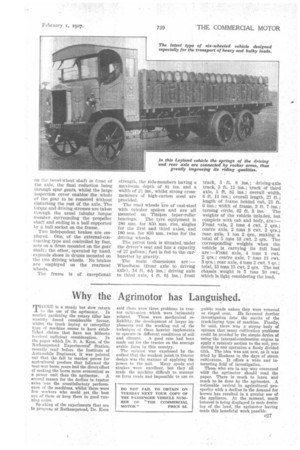Why the Agrirnotor has Languished.
Page 49

If you've noticed an error in this article please click here to report it so we can fix it.
TlIERE is a steady but slow return to the use of the agrimotor. In market gardening the rotary tiller has recently found considerable favour, whilst the track laying or caterpillar typo of machine seems to have established claims that have not hitherto rt.ceived sufficient consideration. In the paper which Dr. R. A, Keen, of the Rothampstead Experimenter Station, recently read before the Institute of Automobile Engineers, it was pointed Out that the fall in market prices for agrimitural produce that followed the ilost-war boom years bad the direct effect of nicking the horse more economical as a power unit than the agrimotor. A second reason for the decline in tractor sales was the unsatisfactory performslam of the machines, whilst there were few workers who could get the best Out of them or keep them in good running order.
Sp•mking of the experiments that are In progress at Rothampstead, Dr. Keen said there were three problems in tractor cultivation which were intimately related. These were mechanical reliability, the development of larger implements and the working out of the technique of these heavier implementsto operate in different conditions of soil and climate. A good ease bad been made out for the tractor on the average arable farrn in this couqry. The opinion was expressed by the author that the weakest point in tractor design was the manner of applying the power to the soil. Many spuds and strakes were excellent, but they all made the machine difficult to manage on farm roads and impossible to use on public roads unless they were removed or ringed over. He favoured further investigation into the merits of the track-laying type of machine. Finally, he said, there was a strong body of opinion that many cultivation problems could be avoided by the simple device of using the internal-combustion engine to apply a rotatory motion to the soil, producing in one operation a finely divided tilth. The idea was not new, as it was tried by Hoskens in the days of steam cultivators. It offers a wide and interesting field of investigation.
Those who are in any way concerned with the agrimotor should read the paper. There is much to learn and much to be done by the agrimotor. A noticeable revival in agricultural prosperity with a decline in the demand for horses has resulted in a greater use of the appliance. At the moment, much interest is being displayed in mole drainlug of the land, the agrimotor having made this beneficial work possible.


































































































